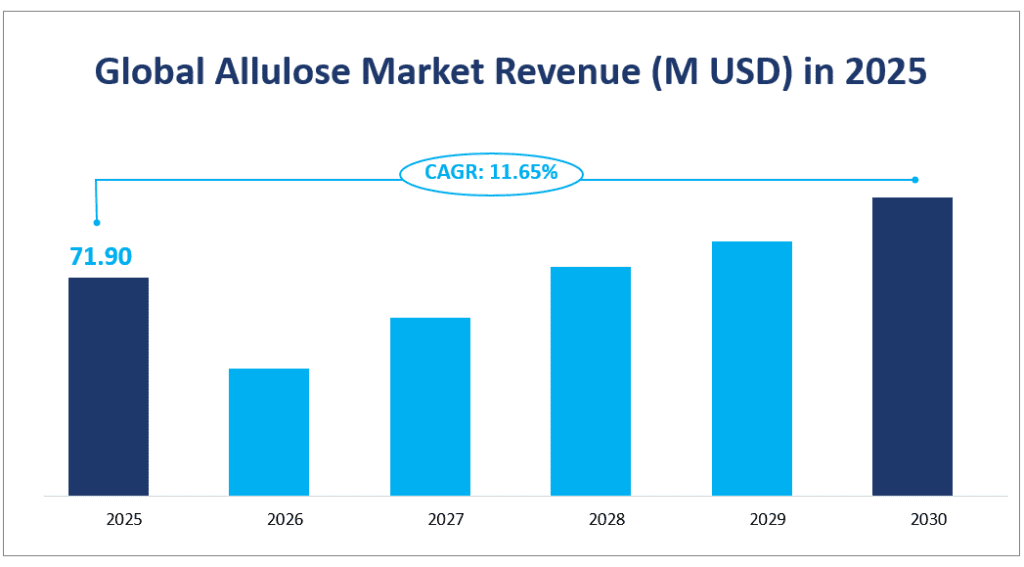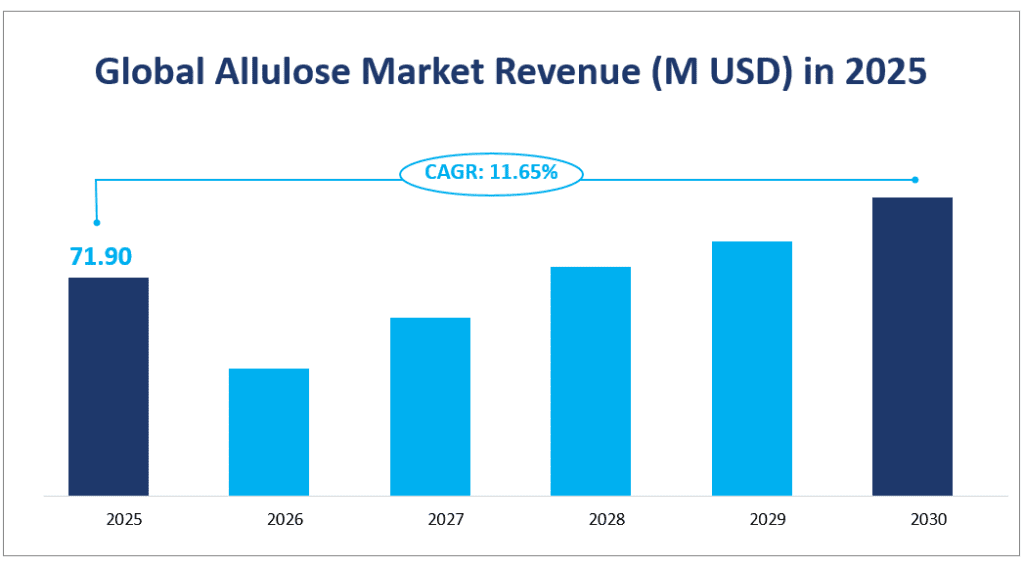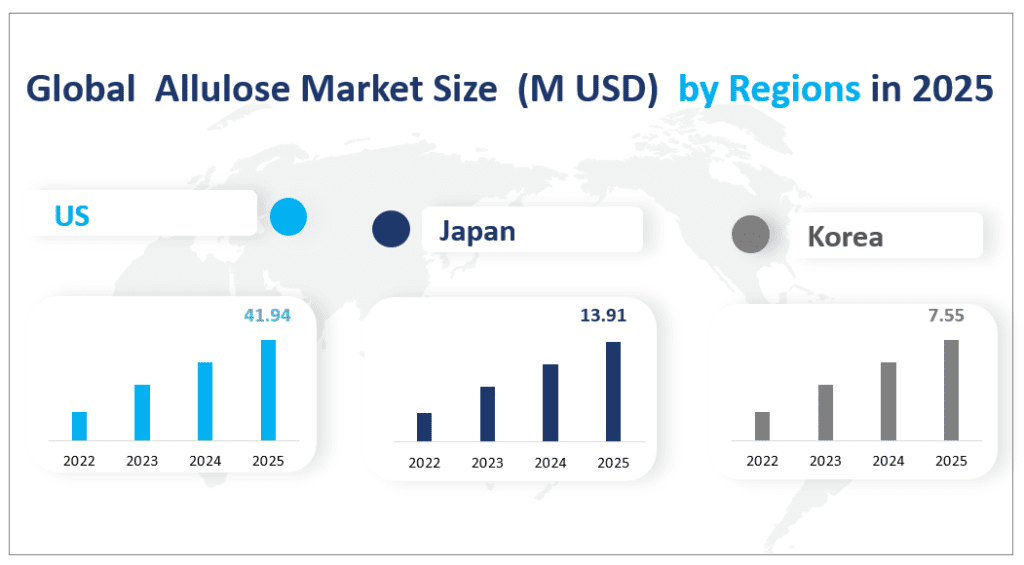1. Global Allulose Market Definition
The global Allulose market revenue is forecasted to reach $71.90 million in 2025 with a CAGR of 11.65% from 2025 to 2030.
Allulose, a low-calorie monosaccharide, and a rare sugar, has gained significant attention in the food and beverage industry due to its unique properties. It is a C3 epimer of fructose, with only 0.2 kcal per gram, making it an ideal sugar substitute for health-conscious consumers. Allulose has 70% of the sweetness of sucrose but with just 0.3% of its energy content. This rare sugar is naturally found in small quantities in fruits like figs and raisins, and it can be produced through the enzymatic conversion of fructose.
Global Allulose Market Revenue (M USD) in 2025


2. Driving Factors of Allulose Market
Health-Conscious Consumer Trends: The rising prevalence of lifestyle-related diseases such as obesity and diabetes has heightened consumer awareness of the importance of a healthy diet. As a result, there is a growing preference for low-calorie and natural sweeteners, which Allulose provides without compromising on taste.
Regulatory Support: In some regions, regulatory bodies are supporting the use of Allulose by exempting it from “sugar” and “added sugar” labels, as seen in the United States. This regulatory stance helps in promoting Allulose as a healthier alternative in food and beverage formulations.
Technological Innovations: Advances in enzymatic conversion processes have made the production of Allulose more efficient and cost-effective. This has enabled manufacturers to produce Allulose at a larger scale, making it more accessible to a broader market.
Expanding Applications: Allulose’s versatility allows it to be used in various food and beverage applications, including baked goods, dairy products, beverages, and confectionery. This wide range of applications ensures that the demand for Allulose continues to grow across multiple industries.
3. Limiting Factors of Allulose Market
High Production Costs: Despite technological advancements, the production of Allulose remains relatively expensive compared to traditional sweeteners. This high cost can limit its adoption by smaller manufacturers and lower-end products.
Limited Production Capacity: The production capacity for Allulose is currently concentrated among a few major players, which can lead to supply constraints and higher prices. Expanding production capacity requires significant investment, which can be a barrier for new entrants.
Consumer Awareness and Acceptance: While awareness of Allulose is growing, it is still not widely recognized by consumers compared to other sweeteners like sucralose or stevia. Building consumer trust and acceptance of Allulose as a safe and effective sweetener will require ongoing education and marketing efforts.
Regulatory Hurdles: In some regions, regulatory approval for Allulose as a food ingredient is still pending or limited. This can restrict its market penetration in certain countries, limiting its overall growth potential.
Analysis of Allulose Market: Product Types and Applications in 2025
Introduction
The Allulose market has been experiencing significant growth in recent years, driven by the increasing demand for low-calorie sweeteners and healthier food alternatives. Allulose, a rare sugar with minimal caloric content and similar taste properties to sucrose, has become a popular ingredient in various food and beverage applications. This article provides an in-depth analysis of the Allulose market, focusing on the different product types and their market revenues, as well as the various applications and their market volumes in 2025.
4. Analysis of Allulose Market Segment
Product Types
Liquid Allulose is one of the most versatile forms of this rare sugar. It is commonly used in beverages, dairy products, and sauces due to its ease of incorporation and compatibility with liquid-based formulations. In 2025, the market revenue for liquid Allulose is forecasted to be $24.78 million. Powder Allulose is another popular form, known for its ease of handling and wide range of applications. It is commonly used in baking, confectionery, and other food products where a granulated sweetener is preferred. In 2025, the market revenue for powder-Allulose is expected to reach $39.55 million, representing the largest market share among all product types.
Crystal Allulose is the least common form but is gaining traction due to its unique texture and suitability for specific applications. It is often used in products where a crystalline structure is desired, such as in some confectionery items and functional foods.
Analysis of Allulose Applications
Bakery products are a significant application area for Allulose, given its ability to provide sweetness and texture without adding excessive calories. In 2025, the market volume for Allulose in bakery products is forecasted to be 1,450.9 tons.
Confectionery is another key application area for Allulose, particularly in products like chocolates, candies, and gums. In 2025, the market volume for Allulose in confectionery is expected to reach 413.9 tons, representing about 5.10% of the total market volume.
Dairy foods, including yogurt, ice cream, and other dairy-based products, are significant users of Allulose due to its ability to enhance taste and texture while reducing calorie content. In 2025, the market volume for Allulose in dairy foods is projected to be 1,738.2 tons.
Therapeutic foods, such as meal replacements and functional foods, are increasingly incorporating Allulose due to its health benefits and low-calorie profile. In 2025, the market volume for Allulose in therapeutic foods is expected to reach 986.8 tons.
Beverages, including carbonated drinks, juices, and functional beverages, are a major application area for Allulose. In 2025, the market volume for Allulose in beverages is forecasted to be 3,085.2 tons, representing the largest market share among all applications.
Among the different applications, beverages hold the largest market share in 2025. This is primarily due to the increasing demand for low-calorie sweeteners in the beverage industry.
Market Revenue and Consumption by Segment
| By Type | Market Revenue (M USD) |
| Liquid Allulose | 24.78 |
| Powder Allulose | 39.55 |
| Crystals Allulose | 7.58 |
| By Application | Market Consumption Volume (Tons) |
| Bakery Products | 1,450.9 |
| Confectionery | 413.9 |
| Dairy Foods | 1,738.2 |
| Therapeutic Foods | 986.8 |
| Beverages | 3,085.2 |
| Others | 439.8 |
5. Regional Allulose Market
The United States remains a dominant player in the Allulose market, driven by its large consumer base and growing health-conscious population. In 2025, the U.S. market is projected to generate a revenue of $41.94 million, reflecting its consistent demand across various industries, particularly in food and beverages.
Japan is another significant market for Allulose, known for its early adoption of functional foods and low-calorie sweeteners. In 2025, Japan’s Allulose market is expected to reach $13.91 million, driven by the increasing demand for health-conscious products and the expanding food and beverage industry.
Korea is emerging as a strong market for Allulose, with significant growth attributed to its growing health and wellness sector. In 2025, Korea’s Allulose market is projected to generate a revenue of $7.55 million, indicating a rapid increase in demand driven by the expanding food and beverage industry.
Mexico’s Allulose market is also experiencing notable growth, driven by the increasing demand for low-calorie sweeteners and functional foods. In 2025, Mexico’s market is expected to reach $3.15 million, making it one of the fastest-growing regions in the Allulose market.
Colombia is another emerging market for Allulose, with significant potential for growth. In 2025, Colombia’s Allulose market is projected to generate a revenue of $1.42 million, indicating a rapid increase in demand driven by the growing health and wellness market.
Among the major regions, the United States holds the largest market share in 2025. This dominance is attributed to the large consumer base, increasing health consciousness, and the expanding food and beverage industry in the U.S.
In terms of growth rates, Colombia emerges as the fastest-growing region. This rapid growth is driven by the increasing demand for low-calorie sweeteners and functional foods, as well as the growing health and wellness market in the region.
Global Allulose Market Size (M USD) by Regions in 2025


6. Analysis of the Top 3 Companies in the Allulose Market
Company Introduction and Business Overview
Matsutani Chemical, established in 1919 and headquartered in Japan, is a leading producer of Allulose. The company specializes in developing and manufacturing edible starch, dietary fiber, and functional ingredients for the food industry. Matsutani Chemical is known for its brand Astraea, which offers high-quality Allulose products.
Products Offered
Matsutani Chemical’s Allulose product, Astraea Allulose, is produced through a proprietary enzymatic conversion process. It is available in powder and liquid forms and is used in various applications, including bakery products, confectionery, dairy foods, and beverages. Astraea Allulose is known for its clean sweet taste, low caloric content, and health benefits.
In 2021, Matsutani Chemical’s Allulose production value reached $14.56 million.
Company Introduction and Business Overview
Tate & Lyle, established in 1921 and headquartered in the UK, is a global supplier of food and beverage ingredients. The company specializes in turning raw materials like corn and tapioca into functional ingredients, including sweeteners, texturants, and wellness ingredients. Tate & Lyle is known for its brand DOLCIA PRIMA®, which offers Allulose-based products.
Products Offered
Tate & Lyle’s Allulose product, DOLCIA PRIMA®, is a low-calorie sweetener that provides the taste and mouthfeel of sugar without the calories. It is available in both crystalline and syrup forms and is used in various applications, including beverages, dairy products, and baked goods. DOLCIA PRIMA® is recognized for its ability to reduce calories while maintaining the sensory appeal of traditional sweeteners.
In 2021, Tate & Lyle’s Allulose production value reached $10.98 million.
Company Introduction and Business Overview
CJ CheilJedang, established in 1953 and headquartered in South Korea, is a leading food and biotechnology company. The company specializes in producing food ingredients, pharmaceuticals, and processed foods. CJ CheilJedang is known for its high-quality Allulose products, which are used in various food and beverage applications.
Products Offered
CJ CheilJedang’s Allulose product is a low-calorie sweetener that offers 70% of the sweetness of sucrose with only 0.2 kcal per gram. The company’s Allulose is available in powder and liquid forms and is used in applications such as beverages, dairy products, and confectionery. CJ CheilJedang’s Allulose is recognized for its health benefits and ability to inhibit fat absorption.
In 2021, CJ CheilJedang’s Allulose production value reached $7.81 million.
Major Players
| Company Name | Headquarters | Sales Region |
| Matsutani Chemical | Japan | Mainly in Asia, North America |
| Tate & Lyle | UK | Mainly in North America, Latin America, Singapore |
| CJ CheilJedang | Korea | Mainly in Asia, North America |
| Samyang Corporation | Korea | Mainly in Korea, USA |
| Savanna Ingredients | Germany | Mainly in Europe |
| Wuxi AccoBio Biotech Inc | China | Mainly in Asia, North America |
1 Industry Overview
1.1 Definition
1.2 Assumptions
1.3 Research Scope
1.4 Market Analysis by Regions
1.4.1 Europe Market States and Outlook (2016-2027)
1.4.2 China Market States and Outlook (2016-2027)
1.4.3 Japan Market States and Outlook (2016-2027)
1.4.4 Korea Market States and Outlook (2016-2027)
1.5 Global Allulose Market Size Analysis from 2016 to 2021
1.5.1 Global Allulose Market Size Analysis from 2016 to 2021 by Consumption Volume
1.5.2 Global Allulose Market Size Analysis from 2016 to 2021 by Value
1.5.3 Global Allulose Price Trends Analysis from 2016 to 2021
2 Global Allulose Market Trends and Growth Strategy
2.1 Market Top Trends
2.2 Market Drivers
2.3 Market Challenges
2.4 Porter’s Five Forces Analysis
2.5 Market Growth Strategy
2.6 SWOT Analysis
3 Company Profiles and Key Figures in Allulose Business
3.1 Matsutani Chemical
3.1.1 Company Profile
3.1.2 Matsutani Chemical Allulose Product Introduction
3.1.3 Matsutani Chemical Allulose Production, Value, Price and Gross Margin (2016-2021)
3.2 Tate & Lyle
3.2.1 Company Profile
3.2.2 Tate & Lyle Allulose Product Introduction
3.2.3 Tate & Lyle Allulose Production, Value, Price and Gross Margin (2016-2021)
3.3 CJ CheilJedang
3.3.1 Company Profile
3.3.2 CJ CheilJedang Allulose Product Introduction
3.3.3 CJ CheilJedang Allulose Production, Value, Price and Gross Margin (2016-2021)
3.4 Samyang Corporation
3.4.1 Company Profile
3.4.2 Samyang Corporation Allulose Product Introduction
3.4.3 Samyang Corporation Allulose Production, Value, Price and Gross Margin (2016-2021)
3.5 Savanna Ingredients
3.5.1 Company Profile
3.5.2 Savanna Ingredients Allulose Product Introduction
3.5.3 Savanna Ingredients Allulose Production, Value, Price and Gross Margin (2016-2021)
3.6 Wuxi AccoBio Biotech Inc
3.6.1 Company Profile
3.6.2 Wuxi AccoBio Biotech Inc Allulose Product Introduction
3.6.3 Wuxi AccoBio Biotech Inc Allulose Production, Value, Price and Gross Margin (2016-2021)
4 Global Allulose Market Competition by Types, Applications, and Top Regions (2016-2021)
4.1 Global Allulose (Volume and Value) by Type
4.1.1 Global Allulose Consumption and Market Share by Type (2016-2021)
4.1.2 Global Allulose Revenue and Market Share by Type (2016-2021)
4.2 Global Allulose (Volume and Value) by Application
4.2.1 Global Allulose Consumption and Market Share by Application (2016-2021)
4.2.2 Global Allulose Revenue and Market Share by Application (2016-2021)
4.3 Global Allulose (Volume and Value) by Regions
4.3.1 Global Allulose Consumption and Market Share by Regions (2016-2021)
4.3.2 Global Allulose Revenue and Market Share by Regions (2016-2021)
5 Global and Regional Allulose Production Market Analysis (2016-2021)
5.1 Global Production Market Analysis
5.1.1 2016-2021 Global Capacity, Production, Capacity Utilization Rate, Ex-Factory Price, Value, Cost, Gross and Gross Margin Analysis
5.1.2 2016-2021 Major Manufacturers Performance and Market Share
5.2 Regional Production Market Analysis
5.2.1 2016-2021 Regional Market Performance and Market Share
5.2.2 Europe Market
5.2.3 China Market
5.2.4 Japan Market
5.2.5 Korea Market
6 Global and Regional Allulose Production, Consumption, Export, Import Analysis (2016-2021)
6.1 Global Allulose Consumption by Regions (2016-2021)
6.2 Japan Allulose Production, Consumption, Export, Import (2016-2021)
6.3 Korea Allulose Production, Consumption, Export, Import (2016-2021)
7 US Allulose Market Analysis by Types, Applications (2016-2021)
7.1 US Allulose Consumption and Value Analysis
7.2 US Allulose Consumption Volume by Types
7.3 US Allulose Consumption Structure by Application
8 Japan Allulose Market Analysis by Types, Applications (2016-2021)
8.1 Japan Allulose Consumption and Value Analysis
8.2 Japan Allulose Consumption Volume by Types
8.3 Japan Allulose Consumption Structure by Application
9 Korea Allulose Market Analysis by Types, Applications (2016-2021)
9.1 Korea Allulose Consumption and Value Analysis
9.2 Korea Allulose Consumption Volume by Types
9.3 Korea Allulose Consumption Structure by Application
10 Mexico Allulose Market Analysis by Types, Applications (2016-2021)
10.1 Mexico Allulose Consumption and Value Analysis
10.2 Mexico Allulose Consumption Volume by Types
10.3 Mexico Allulose Consumption Structure by Application
11 Colombia Allulose Market Analysis by Types, Applications (2016-2021)
11.1 Colombia Allulose Consumption and Value Analysis
11.2 Colombia Allulose Consumption Volume by Types
11.3 Colombia Allulose Consumption Structure by Application
12 Global Allulose Market Forecast by Types, Applications, and Top Regions (2022-2027)
12.1 Global Allulose Consumption Volume, Revenue and Price Forecast (2022-2027)
12.1.1 Global Allulose Consumption Volume and Growth Rate Forecast (2022-2027)
12.1.2 Global Allulose Value and Growth Rate Forecast (2022-2027)
12.2 Global Allulose Consumption Volume, Revenue and Growth Rate Forecast by Region (2022-2027)
12.2.1 Global Allulose Consumption Volume and Growth Rate Forecast by Regions (2022-2027)
12.2.2 Global Allulose Revenue and Growth Rate Forecast by Regions (2022-2027)
12.2.3 US Allulose Consumption Volume, Revenue and Growth Rate Forecast (2022-2027)
12.2.4 Japan Allulose Consumption Volume, Revenue and Growth Rate Forecast (2022-2027)
12.2.5 Korea Allulose Consumption Volume, Revenue and Growth Rate Forecast (2022-2027)
12.2.6 Mexico Allulose Consumption Volume, Revenue and Growth Rate Forecast (2022-2027)
12.2.7 Colombia Allulose Consumption Volume, Revenue and Growth Rate Forecast (2022-2027)
12.3 Global Allulose Consumption Volume, Revenue and Price Forecast by Type (2022-2027)
12.3.1 Global Allulose Consumption Forecast by Type (2022-2027)
12.3.2 Global Allulose Revenue Forecast by Type (2022-2027)
12.3.3 Global Allulose Price Forecast by Type (2022-2027)
12.4 Global Allulose Consumption Volume Forecast by Application (2022-2027)
12.5 Allulose Market Forecast Under COVID-19
13 Global Allulose Marketing Channel, Distributors, Customers and Supply Chain
13.1 Marketing Channel
13.2 Allulose Distributors List
13.3 Allulose Customers
13.4 Allulose Supply Chain Analysis
14 Conclusions
15 Appendix
15.1 Methodology
15.2 Research Data Source
15.2.1 Secondary Data
15.2.2 Primary Data
15.2.3 Market Size Estimation
15.2.4 Legal Disclaimer
